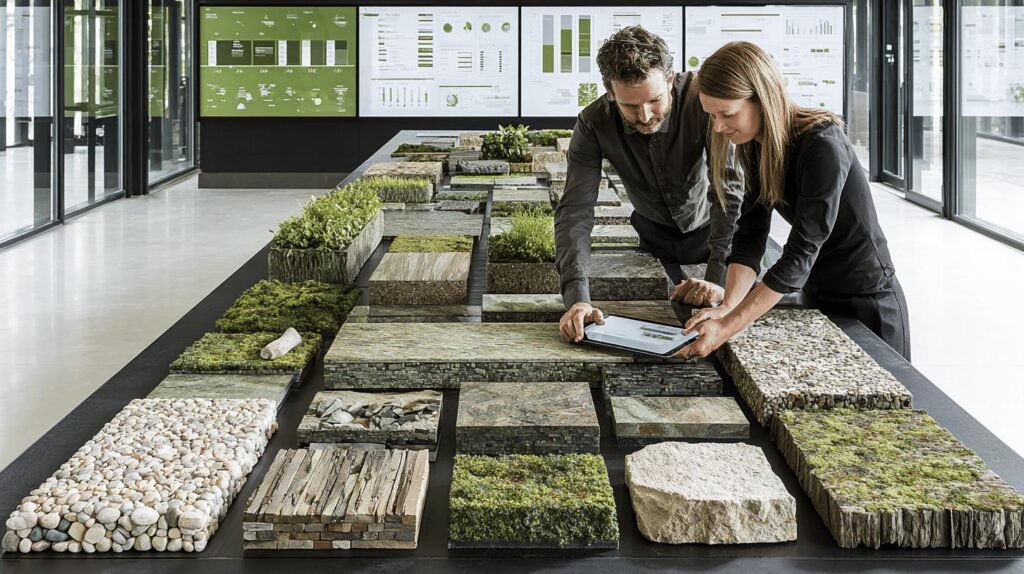
Did you know flooring choices alone can dramatically influence a building’s environmental footprint – producing either major sustainability gains or significant environmental harm? Environmental Product Declaration (EPD) flooring provides transparent, verified insights into a product’s lifecycle impacts, enabling architects and sustainability professionals to make informed green building material selections. Backed by rigorous ISO 14025 and EN 15804 standards, EPD flooring offers measurable proof of environmental performance and supports your efforts in sustainable construction. Here’s everything you need to know about effectively harnessing EPD flooring for your sustainability goals.
What is EPD Flooring and Why Does it Matter?
An Environmental Product Declaration (EPD) is a comprehensive, standardized document that transparently communicates the environmental performance of flooring products. Based on detailed life cycle assessments (LCAs), an EPD captures impacts across the entire lifespan of flooring – from raw material extraction and manufacturing to installation, usage, and eventual disposal.
EPD flooring documentation covers seven critical environmental impact categories:
- Carbon footprint (CO₂ emissions)
- Raw material sourcing and extraction
- Proportion of recycled and bio-based content
- Energy consumption during production
- Impacts on human health
- Ecotoxicity potential
- Waste generation and recycling rates
To guarantee reliability and compliance, flooring EPDs must be independently verified according to internationally recognized standards, such as ISO 14025 and EN 15804. This rigorous verification process ensures data accuracy, allowing architects, sustainability officers, and enterprise decision-makers to confidently select flooring options aligned with their organization’s sustainability objectives.
Selecting flooring products supported by verified EPD certificates not only enhances transparency and regulatory compliance but also advances sustainable construction goals. For example, EPD-certified flooring contributes directly to green building certification scores, including BREEAM, LEED, and DGNB. Such certifications demonstrate a company’s commitment to reducing environmental impacts and addressing stakeholder demands for transparent sustainability reporting.
With growing regulatory pressures and rising environmental awareness, EPD flooring offers a practical solution for managing carbon footprints, improving supply chain transparency, and meeting ambitious net-zero targets – making it an essential consideration for sustainable construction projects.
Key Benefits of Choosing EPD Flooring for Sustainable Projects
Selecting flooring with Environmental Product Declaration (EPD) certifications directly supports sustainability objectives by significantly reducing a building’s environmental impact. Verified EPD flooring products document their complete lifecycle performance, highlighting measurable sustainability advantages, including lower carbon emissions, efficient waste management, and increased potential for recycling and reuse.
Key benefits of incorporating EPD flooring into sustainable building projects include:
- Reduced Carbon Footprint: Advanced carbon footprint floor analysis within EPDs allows architects and supply chain managers to precisely identify and select flooring options that lower overall CO₂ emissions, supporting ambitious net-zero targets.
- Enhanced Waste Management: Durable floor types documented through EPDs typically emphasize recycling, reuse, and optimized material usage, minimizing waste throughout the flooring lifecycle.
- Green Building Certification Credits: Choosing EPD-certified flooring contributes directly toward certification points in leading sustainability rating systems, awarding up to two points under frameworks such as LEED, BREEAM, and DGNB. This helps projects achieve higher sustainability ratings and demonstrates regulatory compliance.
- Proven Sustainability Credentials: Verified EPDs provide transparent evidence of sustainability claims, enabling informed decision-making for supply chain transparency. Practical examples, like Marmoleum sheet flooring, have attained verified CO₂-neutral status, clearly demonstrating the tangible environmental benefits that EPD certification offers.
EPD flooring aligns seamlessly with organizational sustainability commitments and regulatory standards, ensuring that sustainability officers and enterprise decision-makers meet stakeholder expectations and regulatory requirements with confidence.
How EPD Flooring Certification Works: Standards and Processes Explained

Environmental Product Declarations (EPDs) for flooring follow rigorous international certification standards, primarily ISO 14025 and EN 15804. These standards provide a structured framework for transparently reporting the full environmental impacts of flooring products, ensuring credibility, consistency, and comparability across the industry.
To obtain an EPD for flooring, manufacturers must first complete a Life Cycle Assessment (LCA). The LCA comprehensively evaluates the product’s environmental footprint across its entire lifecycle, from raw material extraction and manufacturing to installation, usage, maintenance, and end-of-life disposal or recycling. Key environmental factors assessed include:
- Carbon emissions (greenhouse gases)
- Raw materials sourcing and circularity (recycled or bio-based content)
- Energy and water consumption during production
- Waste generation and disposal practices
- Product composition and construction details
- Impact on human health and ecotoxicity
- Safety and compliance certifications
After the lifecycle assessment is completed, the data is compiled into a standardized, transparent documentation format according to ISO 14025 and EN 15804 requirements. This detailed documentation acts as a comprehensive construction sustainability guide, enabling sustainability officers, architects, and supply chain managers to accurately compare and select sustainable flooring alternatives.
To guarantee accuracy and reliability, the finalized EPD flooring documentation must undergo independent third-party verification. Accredited program operators carefully review the lifecycle assessment methodology, data sources, calculations, and reporting transparency. This third-party verification step ensures compliance with the international eco floor certification standards and lends credibility to the product’s environmental claims.
Once verified, the EPD certification can be publicly communicated and used to support sustainability initiatives, regulatory compliance, and green building certifications such as LEED, BREEAM, or DGNB. By adhering strictly to ISO and EN standards, flooring manufacturers reinforce their commitment to transparency and sustainability, meeting stakeholder demands and differentiating their products in increasingly eco-conscious markets.
Types of Flooring with Available EPD Certifications
Selecting flooring with verified Environmental Product Declarations (EPDs) ensures transparency and measurable sustainability. Multiple flooring types offer robust EPD certifications, empowering sustainability officers and supply chain managers to select solutions aligned with their environmental targets.
Common flooring categories with recognized EPDs include:
- Solid Hardwood Flooring: Renowned for durability and natural aesthetics, solid hardwood floors often have detailed EPD certificates documenting lifecycle impacts. For example, Junckers’ 2-strip parquet flooring provides transparent EPD data on material sourcing, production processes, and environmental performance – empowering informed decisions in sustainable building projects.
- Engineered Wood Flooring: Combining real wood layers with engineered backing, engineered wood flooring offers enhanced stability and eco-efficiency. Manufacturers typically provide EPD documents outlining the environmental footprint of production methods, sourcing of raw materials, and carbon emission data across their product lifecycle.
- Luxury Vinyl Tile (LVT) and Vinyl-Based Tile (VBT): Resilient vinyl flooring options, such as Armstrong’s luxury vinyl tile and vinyl-based products, feature comprehensive EPDs highlighting impacts on raw material sourcing, emission profiles, and recycling potentials. These EPD documents support decision-makers in achieving sustainability compliance and optimizing carbon footprint management.
- Laminate Flooring: Laminate options offer affordable, durable alternatives to hardwood. Their EPD certifications transparently outline environmental impacts, including energy use during manufacturing and end-of-life recyclability. This enables accurate laminate versus hardwood sustainability comparisons supporting targeted sustainability goals.
- Linoleum Flooring: Often made from renewable materials like linseed oil, linoleum flooring typically achieves strong sustainability credentials. EPD certificates detail its renewable composition, low-emission characteristics, and recyclability – highlighting linoleum as a viable eco-friendly flooring solution.
EPD certifications across these flooring types provide clear, quantifiable environmental data for informed purchasing decisions, regulatory compliance, and effective carbon footprint reduction strategies.
Vinyl vs Laminate: An EPD Flooring Environmental Comparison
When selecting sustainable flooring materials, comparing Environmental Product Declarations (EPDs) for vinyl and laminate flooring can provide critical insights into their environmental performance. Both flooring types offer verified EPD documentation, transparently reporting their carbon footprints, material sourcing, and lifecycle impacts.
Luxury vinyl tile (LVT) and vinyl-based tile (VBT) flooring products, such as those manufactured by Armstrong, clearly outline their environmental profiles through detailed EPDs. These documents cover specific impacts, including greenhouse gas emissions during production, recycled content integration, and end-of-life recyclability. Vinyl flooring often demonstrates durability and ease of maintenance, potentially reducing resource use and emissions over its operational lifespan.
Laminate flooring similarly provides robust EPD documentation, delivering transparency on its sustainability credentials. Laminate’s EPDs typically emphasize lower energy consumption in manufacturing, responsible sourcing of raw materials, and opportunities for recycling post-use. Due to its construction, laminate flooring frequently contains recycled wood fibers, contributing positively to circular economy goals.
Comparative factors for architects and sustainability officers to assess vinyl versus laminate green performance include:
- Carbon Footprint: Laminate flooring generally reports lower manufacturing emissions, while vinyl flooring’s longevity may offset higher initial impacts.
- Material Sourcing and Circularity: Laminate often incorporates recycled content, whereas vinyl flooring’s recyclability varies significantly depending on specific products and manufacturers.
- Lifecycle Durability: Vinyl typically lasts longer, potentially reducing replacement frequency and associated lifecycle impacts.
Analyzing EPD flooring documentation empowers sustainability professionals to select flooring solutions aligned with their environmental priorities and compliance requirements.
Practical Guide to Selecting and Sourcing EPD Flooring
Selecting flooring with verified Environmental Product Declarations (EPDs) helps architects, supply chain managers, and sustainability officers confidently meet sustainability and compliance goals. When sourcing EPD flooring, consider these key factors carefully:
- Verify Authentic EPD Certificates: Ensure the EPD is independently verified according to ISO 14025 and EN 15804 standards. Genuine EPDs transparently document environmental impacts like carbon emissions, energy consumption, and waste management.
- Evaluate Material Composition: Examine the proportion of recycled and bio-based materials outlined clearly within each declaration. Higher recycled content and renewable materials lower overall environmental footprints.
- Assess Production Location: Prioritize flooring products manufactured locally or within shorter supply chains. Reduced transportation distances significantly decrease associated carbon emissions.
- Check for Durability and Lifespan: Durable floor types such as resilient vinyl and eco-laminate often feature comprehensive EPD documentation. Products with longer lifespans typically deliver lower lifetime environmental impacts.
Trusted retailers, including Lowe’s and specialized online shops for eco laminate surfaces, clearly display EPD certificates and environmental credentials for flooring products. Retailer guides for resilient vinyl selection provide straightforward summaries of sustainability claims, supporting transparent decision-making.
For accurate comparisons, carefully review the EPD data presented, including carbon footprints, recyclability, and energy usage. Reliable EPDs allow you to directly compare flooring materials and select solutions that best align with your project’s sustainability targets and regulatory compliance requirements.
Installation Best Practices for Maximizing EPD Flooring Sustainability
Proper installation practices significantly impact the sustainability and durability of EPD flooring, directly supporting the environmental goals outlined in a product’s Environmental Product Declaration (EPD). Considering the following best practices ensures minimal waste generation, reduced emissions, and an extended lifespan for eco-friendly flooring solutions:
- Prepare the Subfloor Properly: Adequate subfloor preparation is crucial to optimize flooring performance. Ensure the subfloor is clean, dry, level, and free of contaminants, which reduces material waste and promotes durability.
- Use Low-VOC Adhesives: Volatile Organic Compounds (VOCs) negatively impact indoor air quality. Select adhesives certified as low-VOC or VOC-free to maintain indoor environmental health and comply with sustainability standards.
- Optimize Material Use: Minimize material waste by carefully measuring the installation area and planning flooring layout. Precise measurement and pattern planning ensure efficient use of laminate, vinyl sheets, or hardwood planks, preserving resources and lowering overall environmental footprint.
- Implement Responsible Waste Management: Collect and segregate flooring waste, recycling offcuts whenever possible. Responsible disposal practices support circular economy principles and align with sustainability objectives.
- Follow Manufacturer Installation Guidelines: Adhering strictly to detailed step-by-step installation guides – such as those provided for laminate flooring or bathroom sheet vinyl eco solutions – not only improves installation quality but also extends flooring lifespan and reduces the likelihood of premature replacement.
- Regular Maintenance Planning: Plan for ongoing, sustainable maintenance practices. Proper care, including the use of eco-friendly cleaning products and regular inspections, prolongs flooring lifespan and maintains the environmental integrity documented in EPD flooring certifications.
Real-World Case Studies: Successful Implementations of EPD Flooring
Implementing Environmental Product Declaration (EPD) flooring provides tangible sustainability advantages, as demonstrated by real-world applications across various sectors. These case studies highlight measurable environmental outcomes, insights from advanced carbon footprint floor analysis, and valuable lessons learned.
Marmoleum sheet flooring, produced by Forbo, offers a clear example of impactful sustainability results validated through EPD certification. For instance, Marmoleum achieved CO₂-neutral status throughout its lifecycle. This significant achievement was possible by meticulously analyzing environmental impacts, sourcing sustainable raw materials, optimizing manufacturing processes, and prioritizing recyclability. This measurable sustainability outcome makes Marmoleum a preferred flooring choice for institutional buildings, healthcare facilities, and educational projects aiming for rigorous sustainability standards.
Solid hardwood flooring by manufacturers like Junckers provides another illustrative example. Junckers collaborated closely with sustainability consultants to compile detailed lifecycle impact data into verified EPD documentation. Through this collaborative analysis, Junckers successfully pinpointed environmental hotspots and improved production methods – resulting in lower energy consumption, reduced emissions, and increased recycling rates. Junckers’ EPD flooring has supported commercial and residential projects in achieving sustainability certifications, including LEED Gold and BREEAM Excellent ratings.
Furthermore, Armstrong Flooring’s luxury vinyl tile (LVT) and vinyl-based tile (VBT) flooring installations in commercial retail environments exemplify the benefits of comprehensive lifecycle assessment and EPD verification. By documenting the material sourcing, manufacturing emissions, and recyclability potential, Armstrong Flooring enabled sustainability officers to precisely assess environmental impacts and select flooring options that align with corporate sustainability strategies. Retail chains leveraging Armstrong’s EPD-certified flooring successfully documented significant reductions in Scope 3 emissions, contributing directly to their corporate sustainability reporting and compliance goals.
These practical case studies confirm the value of EPD flooring in delivering quantifiable sustainability outcomes, simplifying compliance with stringent environmental regulations, and effectively addressing stakeholder expectations in sustainability performance.
Final Words
Taking action to integrate EPD flooring into sustainable construction projects provides measurable environmental benefits and contributes directly to achieving green certifications.
With detailed, third-party-verified insights available, choosing flooring with an Environmental Product Declaration becomes a practical means of enhancing transparency, reducing carbon footprints, and promoting environmentally responsible designs.
By prioritizing materials with verified EPD flooring documentation, architects, developers, and sustainability professionals can effectively align construction practices with sustainability targets, helping build a healthier future – one project at a time.
FAQ
Q: What does EPD stand for in flooring?
A: EPD stands for Environmental Product Declaration, a standardized, independently verified document detailing a flooring product’s lifecycle environmental impact, including carbon footprint, raw material use, and potential human and environmental health effects.
Q: Why is choosing flooring with EPD certification beneficial?
A: Choosing flooring with EPD certification helps reduce a building’s environmental impact, achieve sustainability credentials, and can earn additional points toward green building certifications like LEED, BREEAM, or DGNB.
Q: Which types of flooring typically have EPD certifications?
A: Flooring products commonly carrying EPD certifications include solid hardwood, engineered wood, luxury vinyl tile (LVT), vinyl-based tile (VBT), laminate, linoleum, and modular resilient flooring.
Q: Which flooring option is more sustainable, vinyl or laminate?
A: Both vinyl (including LVT/VBT) and laminate flooring have detailed EPDs, though specific environmental impacts differ based on sourcing, recycled content, production processes, and emissions – EPDs facilitate accurate comparison for informed decision-making.
Q: How do I select and source EPD-certified flooring effectively?
A: Selecting EPD-certified flooring involves reviewing verified EPDs, assessing recycled and bio-based content, considering production location, and choosing reputable suppliers or retailers offering transparency in sustainability credentials and documentation.
Q: What installation practices maximize the environmental benefits of EPD-certified flooring?
A: Maximizing sustainability of EPD-certified flooring requires following installation best practices like precise subfloor preparation, efficient material usage to reduce waste, application of low-VOC adhesives, and adherence to manufacturer installation guidelines.
Q: What are examples of successful EPD flooring implementations in real-world projects?
A: Projects such as the deployment of Marmoleum sheet flooring achieving carbon neutrality and Junckers’ hardwood installations demonstrate measurable sustainability outcomes and positive contributions toward LEED and BREEAM green building certifications.
Q: What is EPDM flooring and is it a sustainable choice?
A: EPDM flooring, made from synthetic rubber, provides durability, slip resistance, and noise reduction, making it suitable for commercial applications; sustainability depends on factors such as manufacturing methods, EPD transparency, and recycled content.

